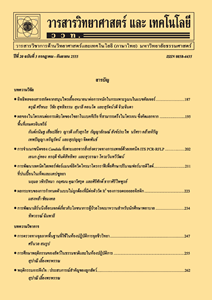การลดก๊าซไฮโดรเจนซัลไฟด์ความเข้มข้นสูงในก๊าซชีวภาพด้วยกระบวนการร่วมเคมีและชีวภาพ
Main Article Content
Abstract
The objective of this research is to investigate the effects of H2S loading rate and total alkalinity on removal efficiency of high concentrated H2S obtained from biogas production from ethanol industry wastewater (molasses wastewater) by anaerobic digestion. Biogas produced from ethanol wastewater consists of 69.5-74.0 % methane, 25.3-28.1 % carbon dioxide and more 10,000 ppm hydrogen sulfide. The reactor works with combined chemical and biological processes to solve the problem of clogging of the sulfur sediment in the system. The reactor includes reaction tank, aerator tank, sedimentation tank and water tank, with the addition of Paracoccus sp. bacteria into aerator tank, filling only once at startup. The results showed that the efficiency of the removal of H2S was 99.9±0.1 %, methane was increased 12.2-16.5 % and carbon dioxide was reduced 36.6-53.2 %, in condition of the H2S loading rate at 150 and 300 g H2S/m3-h and wastewater alkalinity controlled at 4,500 mg/L as CaCO3. At the 600 g H2S/m3-h H2S loading rate and 12,000 mg/L as CaCO3 alkalinity, it was found that a trace amount of hydrogen sulfide was also simultaneously reduced to 0-18 ppm.
Article Details
References
[2] Department of Alternative Energy Development and Efficiency, 2015, Alternative Energy Development Plan 2015-2036, Available Source: http://www.dede.go.th/download/files/AEDP2015_Final_version.pdf, October 20, 2018. (in Thai)
[3] Kasetsart Agricultural and Agro-Industrial Product Improvement Institute Kasetsart University, 2006, The Utilization of Wastes from Ethanol Industry, Report, Department of Alternative Energy Development and Efficiency, Ministry of Energy, Bangkok, 20 p. (in Thai)
[4] HSDB, 2014, Hydrogen Sulfide. Available Source: https://toxnet.nlm.nih.gov/cgi-in/sis/search/a?dbs+hsdb:@term+@DOCNO+576, December 19, 2018.
[5] Ekburanawat, W., 2012, Hydrogen Sulfide, Available Source: http://www.summacheeva.org/index_thaitox_hydrogen_sulfide.htm, December 19, 2018. (in Thai)
[6] Arunraj, P., Bunyakan, C. and Chungsiriporn, J., 2009, Hydrogen sulfide removal by absorption and oxidation reaction with potassium permanganate in packed column absorber, pp. 113-119, 7th PSU-Engineering Conference, Prince of Songkla University, Songkla. (in Thai)
[7] Pongkiatkul, P., 2015, Biogas Technology Available Source: http://php.diw.go.th/safety/wp-content/uploads/2015/02/KM%20DIW%20Presentation.pdf, December 19, 2018. (in Thai)
[8] Chaiprapat, S., Mardthing, R., Kantachote, D. and Karnchanawong, S., 2011, Removal of hydrogen sulfide by complete aerobic oxidation in acidic biofiltration, Process Biochem. 46: 344-352.
[9] Namgung, H.K., Ahn, H.Y. and Song, J., 2012, Development of a two-phase bioreactor for biological removal of hydrogen sulfide from biogas, Energy Procedia 14: 1143-1148
[10] Chaiprapat, S., Kantachote, D. and Charnnok, B., 2012, Remove Hydrogen Sulfide Simultaneously with Sulfuric Acid Production from Biogas in Concentrated Rubber Latex Industry by Chemical Absorption and Combined with Biofiltration, Research Report, Prince of Songkla University, Songkla, 161 p. (in Thai)
[11] Rattana, S., Juntima, C. and Janya, I., 2009, Removal of H2S in biogas from concentrated latex industry with iron(III) chelate in packed column, Songklanakarin J. Sci. Technol. 100: 195-230.
[11] Tiippayawong, N. and Thanompongchart, P., 2010, Biogas quality upgrade by simultaneous removal of CO2 and H2S in a packed column reactor, Energy 35: 4531-4535.
[12] Do, K.U., Nghiem, T.D., Shin, D.K., Nguyen, T.T.H., Ly, B.T. and Tran, D.C., 2016, Application of iron-based adsorbent (FEOOH) to remove hydrogen sulfide (H2S) from biogas, J. Sci. Technol. 54: 35-41.


